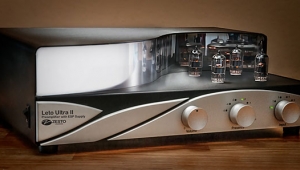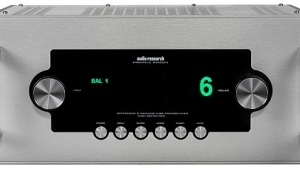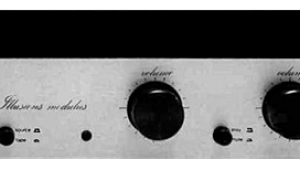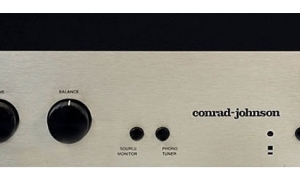| Columns Retired Columns & Blogs |
VTL TL-6.5 Signature line preamplifier Wes Phillips, July 2008
Wes Phillips auditioned the VTL TL-6.5 Signature in July 2008 (Vol.31 No.7):
Mom was right: "You get only one chance to make a first impression." For Luke Manley, VTL, and me, that first impression came about 22 years ago, when I was selling hi-fi at a store in New York City, and Manley came by to try to interest us in carrying VTL gear.
Assuming my memory can be trusted, at the time, the entire VTL line probably consisted of only a pair of stereo power amplifiers and a preamplifier or two. They didn't quite look homemade so much as industrial: big, basic, and brawny.
Both Luke Manley and VTL were downright scruffy in those days. However, those early days taught Manley a lot. While he never doubted that vacuum tubes were the right—no, the only choice for high-fidelity music reproduction, he conceded that many audiophiles had legitimate objections to buying tubed components: they had a reputation for breaking down, they required fiddly biasing, they drifted out of alignment—in short, they were funky.
So Manley set about reinventing VTL's line. He completely retooled his products' industrial design so that they no longer looked daunting or strange. He added microprocessors to perform tube housekeeping chores such as bias adjustment. He adopted solid-state power supplies, believing that tube supplies—lacking, as they did, the current to drive large capacitor banks—soften the sound; not to mention that they require frequent tube changes to prevent frying said capacitors. "Essentially," Manley said, "I wanted to eliminate every valid reason for rejecting vacuum tubes, while retaining the reason you'd want them: they're superior to transistors.
"Not that I have anything against transistors," he continued. "I use tubes in the voltage-gain section of the TL-6.5 for their inherent linearity, but I use MOSFETs in the buffer stage because they have superior current linearity. As a hybrid circuit, the 6.5 can drive a wide variety of cable and amplifier loads."
Why do I recount this evolution of VTL, which has been well documented in Stereophile over the years? Well, I knew it intellectually—and, in the last five years' worth Home Entertainment and Consumer Electronics shows, have saved VTL's demos for late in the last day so that my take-away impression of those events was always of great sound. But when I think of the marque, I still remember scruffy Luke Manley and funky VTL.
Judging from my recent experiences with the TL-6.5 Signature ($9500), that long-remembered first impression is now completely, 100% wrong. The TL-6.5, first reviewed for Stereophile by Larry Greenhill in June 2007, is as beautifully built as any audio component I've auditioned. Its innards are downright impressive, and its façade is stunning. The preamp is also impressively heavy—even for $10,000, you get a lot of preamplifier.
Setup was straightforward: I connected my long-term reference universal player, the Ayre Acoustics C-5xe, via its superior-sounding balanced outputs—and my even-longer-term reference power amp, Musical Fidelity's Nu-Vista 300, by way of its single-ended inputs. On switch-on, the VTL flashed its standby lights at me for the warmup period, then informed me that I'd set the gain to "00." A touch of the remote control and we were up and running—simple as pi.
But Jethro H. Tull, I was unprepared for the TL-6.5's bottom-end slam and top-end sparkle. If you harbor any illusions about "tube sound" or "solid-state sound," the VTL will disabuse you of them fast. William Shatner's completely rocking cover of Pulp's "Common People," from his Has Been (CD, Shout! Factory 30349), cut like a knife—Adrian Belew's buzz-saw guitar was kicked along by Matt Chamberlain's busy drumming, creating an authentically punkish din behind Shatner's over-emotional delivery. And when Shatner delivers the refrain, "'Cos when you're laid in bed at night / watching roaches climb the walls / if you call your Dad, he could end it all," the band, the chorus, and Joe Jackson all lay out in a stutter-stop that accentuates just how busy the arrangement is. Those glaring moments of silence also emphasized the TL-6.5's unrestricted dynamic range.
What the TL-6.5 Signature reminded me of most was another genre-crossing preamplifier, the most un–solid-state–sounding Ayre K-1xe. Both are dead quiet, and both have bottom-end extension that will almost bruise you—in fact, when I played an orchestral spectacular of music by Borodin that inspired Kismet, on Erich Kunzel and the Cincinnati Symphony's Boléro (SACD, Telarc SACD-60703), I felt the VTL had greater weight.
Not that it sounded "heavy." Its top end was extended and unfettered, floating Anna Sofie von Otter's complex mezzo-soprano with remarkable purity on Terezen/Theresienstadt (CD, Deutsche Grammophon 477 654 6). As I listened to von Otter, the VTL remained true to its tube heritage: without adding sweetness or warmth, it nevertheless glorified the human voice with an almost magical reality. When reviewers—well, I, at any rate—resort to such criticspeak as palpability, what we're attempting to convey is that sense of a sound being solid enough to touch. That's precisely what the TL-6.5 delivered: sound that this doubting Thomas could aurally caress.
This quality was stunningly present in Todd Garfinkle's remarkable recording of Bach's Orgelbüchlein, performed by Ensemble Mare Nostrum (CD, M•A Recordings M076A). Céline Scheen's soprano floated above the portative organ and continuo with an astonishing weightlessness, yet the viols were concretely anchored beneath her voice. The VTL capably accorded each voice precisely the right degree of reality.
Of course, right is a relative term, but it's the [ahem] appropriate one to use regarding the VTL TL-6.5 Signature. On recording after recording, in comparison after comparison, it just sounded...right.
In the end, VTL managed to make a second first impression on me: Twenty-odd years into the game, they're one of the heavyweight players, making audio components that rank among the most impressive I've auditioned in my system. Whether that indicates improvement on VTL's part or increased perspicacity on mine, I decline to speculate.—Wes Phillips
- Log in or register to post comments




































